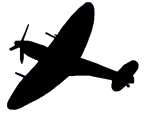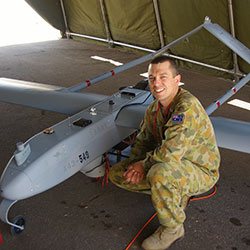The 2009 recipient of the Spitfire Memorial Defence Fellowship was Lieutenant Colonel Keirin Joyce. His Fellowship enables him to improve the capability and support of Unmanned Aerial Vehicles (UAVs).
Considering that UAVs are a ubiquitous part of modern warfare, used for reconnaissance and surveillance, in 2009 the Australian Army was undertaking a project to acquire a tactical UAV: the ADF’s first UAV to be brought into service. Then Major Keirin Joyce, a logistics and aerospace engineer with the Army, was posted to the Defence Materiel Organisation (DMO) to help with this task, and to prepare future acquisition strategies for drones. As part of his recently completed Masters of Science in Aerospace Engineering at University of New South Wales, Canberra, Joyce studied the service of the Army’s existing UAV trials, as well as a range of international introduction into service (IIS) reports. Anecdotal evidence and data from these reports about the performance of different UAVs was used to inform the Army and DMO’s strategy. Joyce, who had concurrently begun a four-year doctorate program in modelling UAV logistic support, was awarded the Spitfire Memorial Defence Fellowship. The Fellowship enabled him to attend important conferences in the UK and the US, where he met with researchers from NASA, the US Air Force and Army, as well as UAV capability managers in the Pentagon.
Prior to his work on drone acquisitions, Joyce was the engineering officer at the 20th Surveillance and Target Acquisition Regiment. In this role he was deployed to both Iraq and Afghanistan, and was part of a team developing tactical UAV capabilities in combat. Joyce has since been consulted by both Air Force and Navy in the development and support of their own emerging UAV capabilities and was awarded the Chief of Army Scholarship to continue his PhD research in 2014. Using all of these skills and education LTCOL Joyce ran the Army UAS Sub-Program in 2017-19 and over these three years brought four more types of UAV into Army inventory. From the Army perspective, drones are a force multiplier that make their soldiers’ lives safer and better. “UAS make soldiers safer, removing them from some of their dangerous situations, and make Army Commanders and teams more effective”, says Joyce. “Soldiers are safer because they can send a UAS down a street, into an intersection or over a hill to have the first look, instead of a soldier – soldiers are safer today because of our UAS projects. Army is more effective because the images and data allow better, quicker decisions to be made by our mission Commanders”. The Australian Army is now one of the world’s leading adopters of UAV technology.
LTCOL Joyce, now a 23-year veteran of the Army, having spent the last 14 in support of the UAV capability, was this year posted to Air Force. His new role in Air Force HQ is to bring the Air Force Remotely Piloted Aircraft Systems (RPAS) Sub-Program into service, which will include the first fully-certified systems to fly in Australian airspace. Why does he love this field so much? “Big bang for buck on investment, high rates of tech refresh and development, safer soldiers, better effectiveness for missions – It’s easy to be a huge advocate when you are inspired by this scenario at work every day!”


